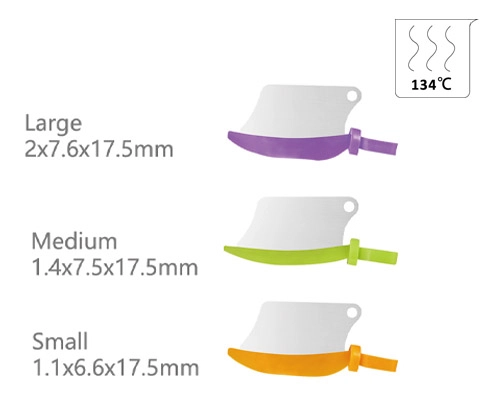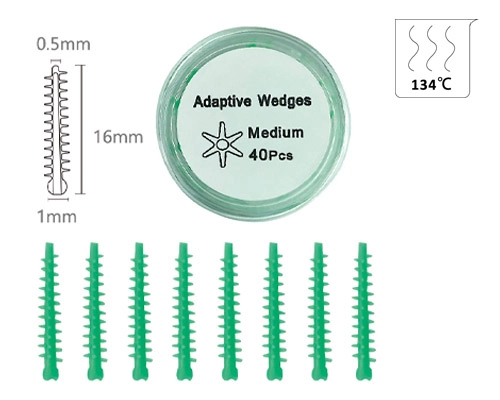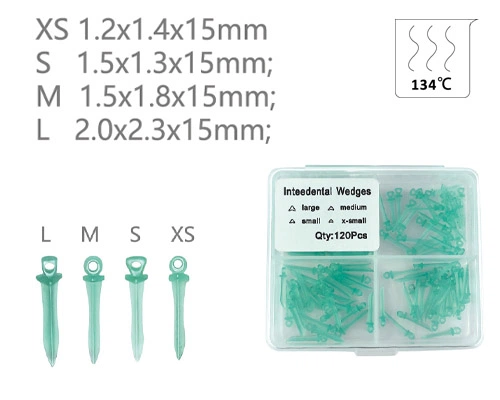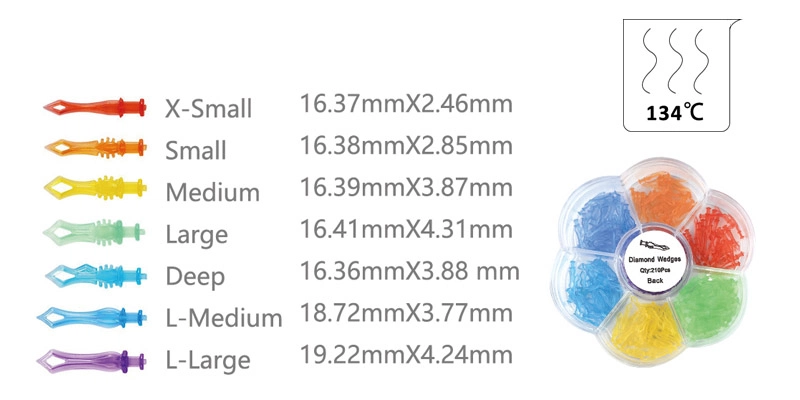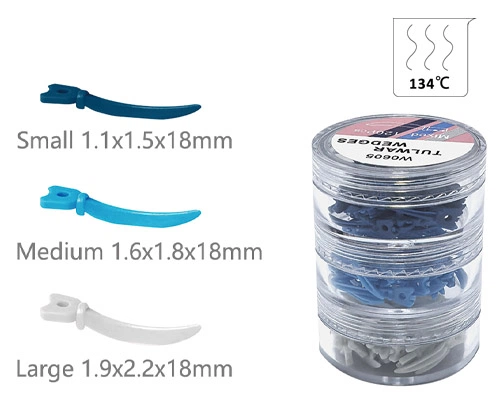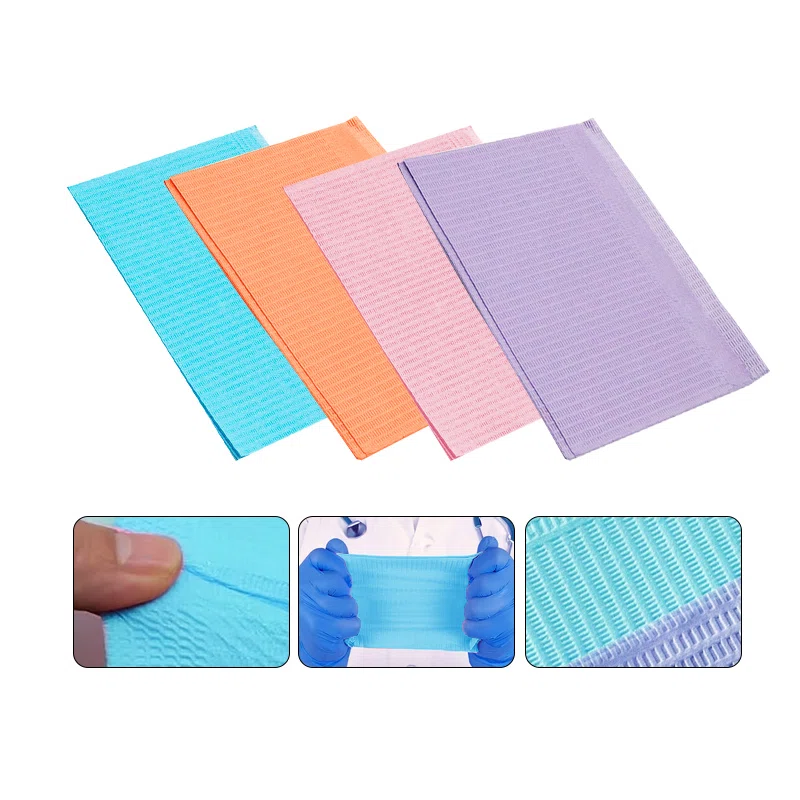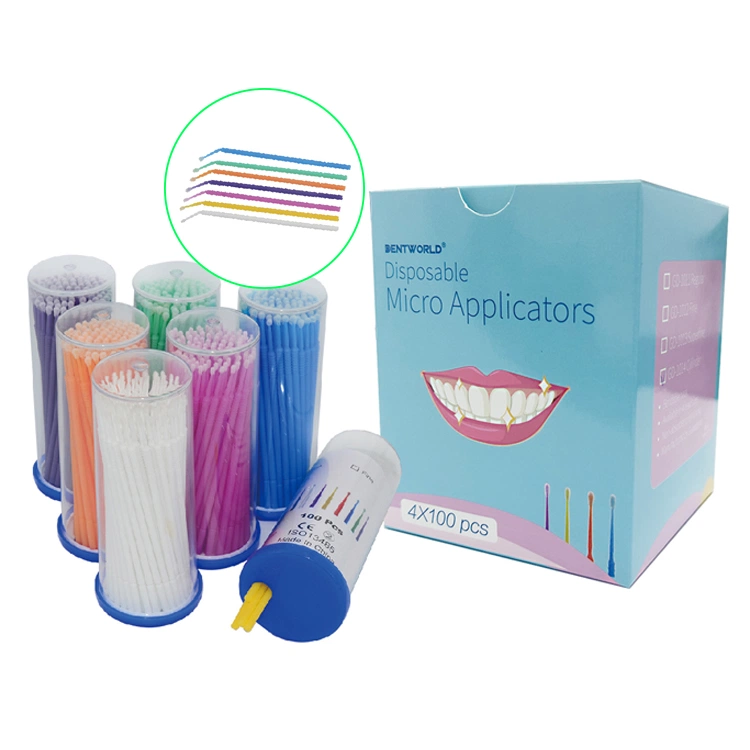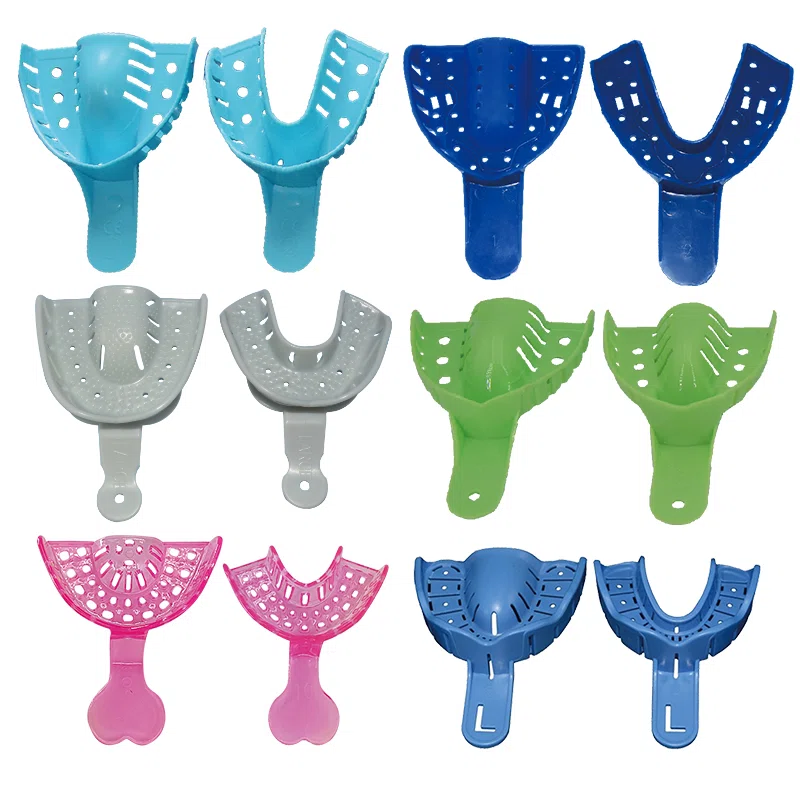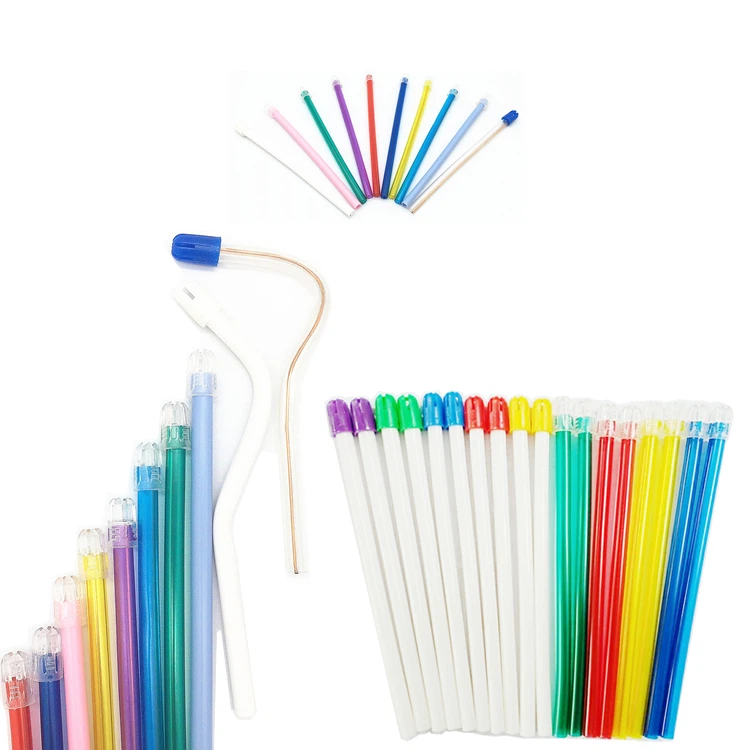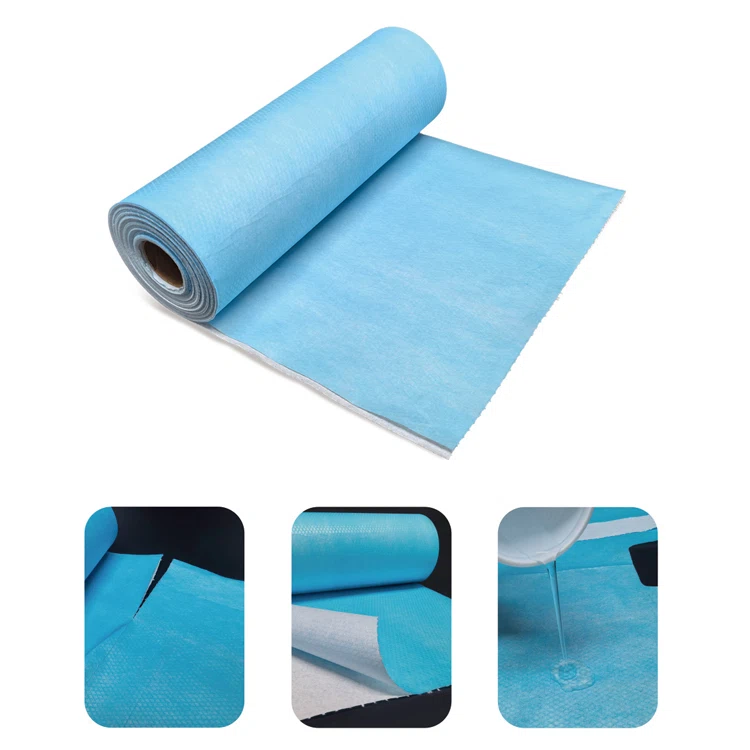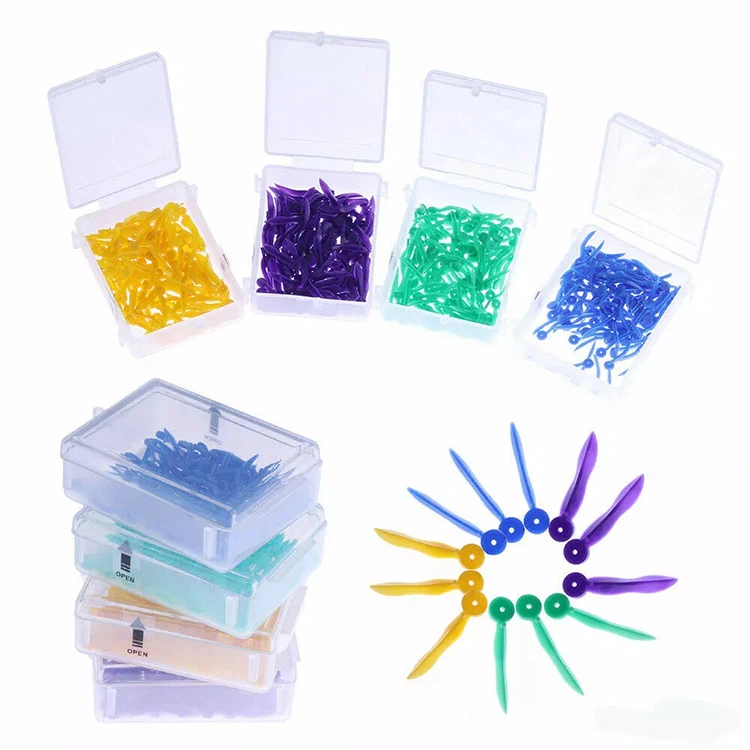
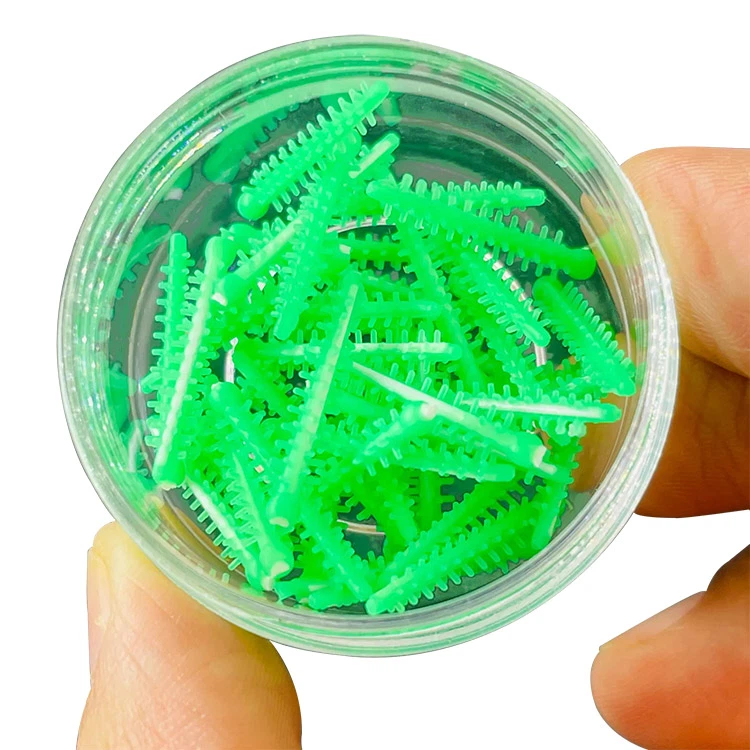
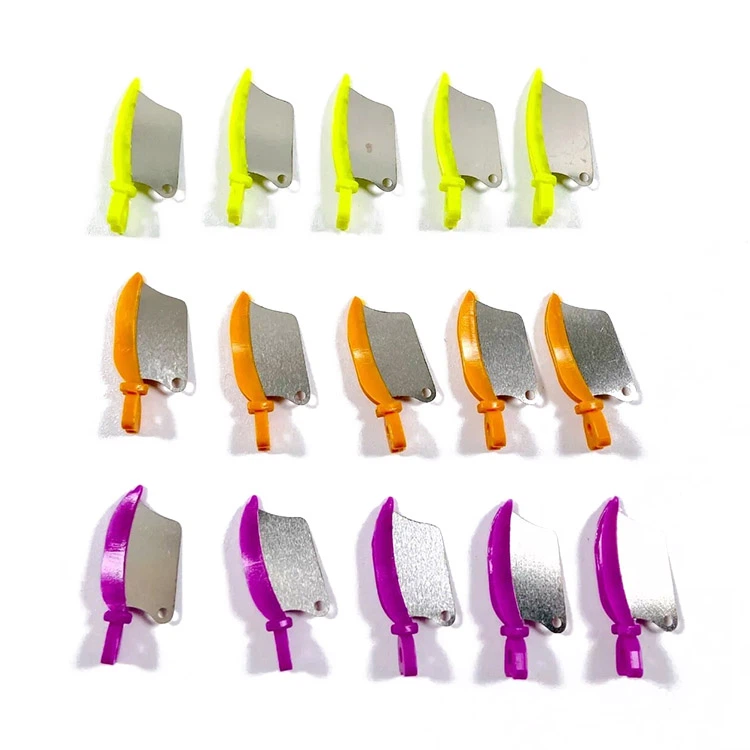
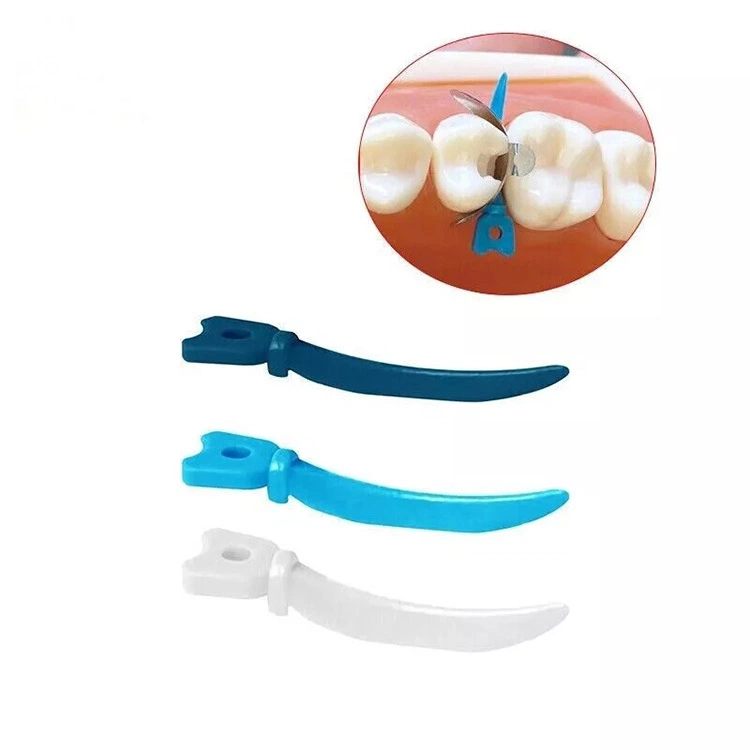
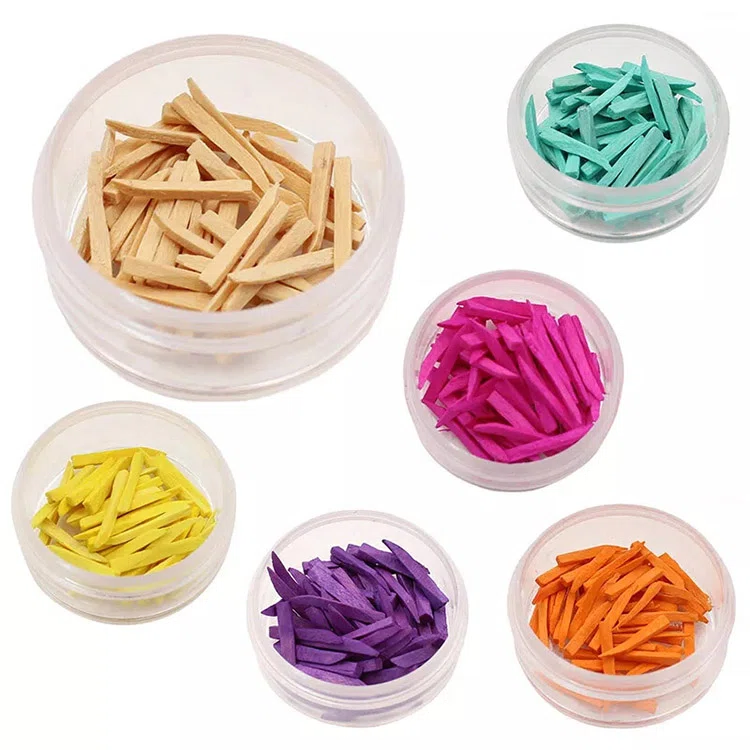
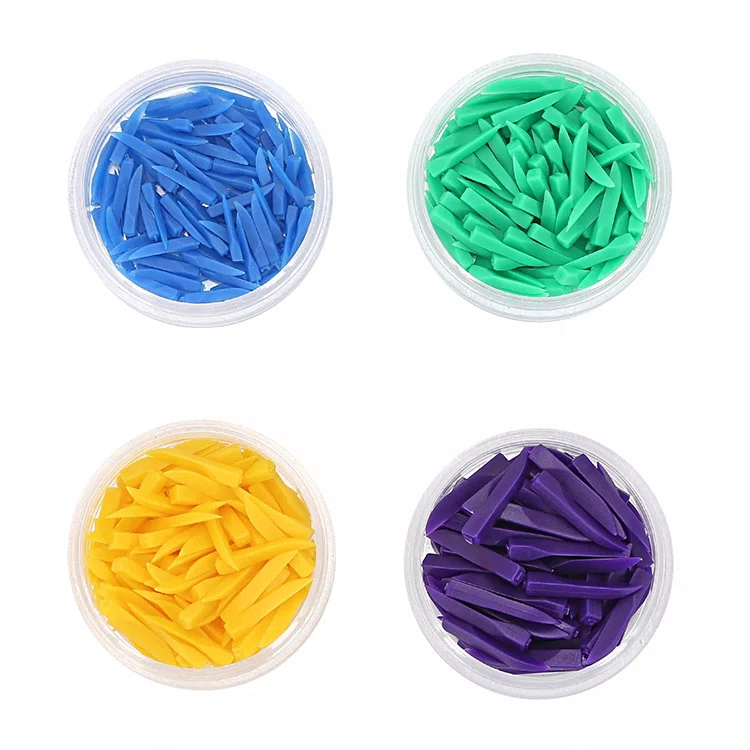
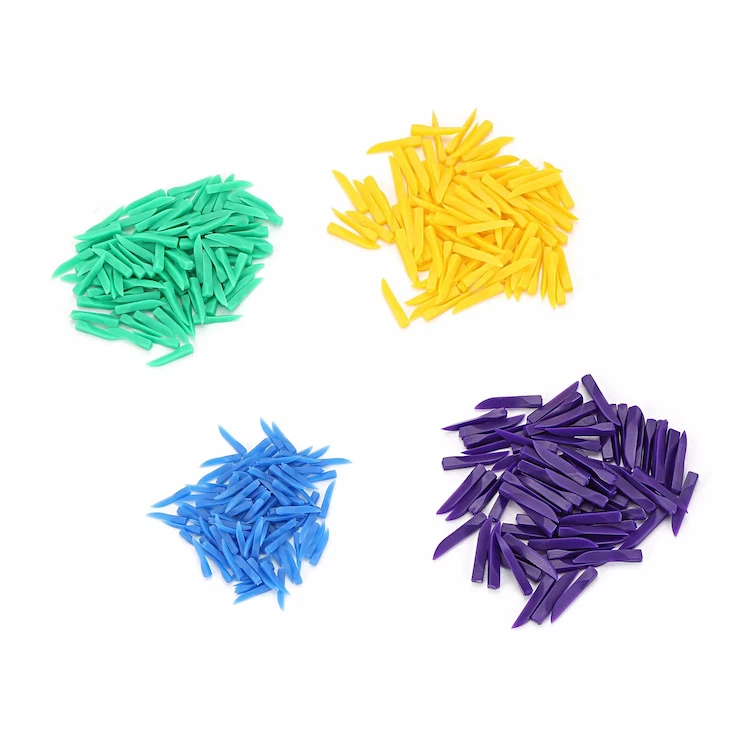
치과 웨지
- 고품질 재료: 의료용 플라스틱으로 만들어졌습니다, 일회용 용도로 안전을 보장하고 오염 방지
- 다목적 사이징: 다양한 크기로 디자인 - 다양한 개간 공간을 수용합니다
- 완벽한 착용감: 이 웨지는 치아 사이에 꼭 맞도록 설계되었습니다, 정확한 복원 및 충전 절차를 지원합니다
치과 웨지는 일반적으로 목재로 만들어집니다, 플라스틱, 고무는 치아 사이의 간격을 채우고 치료 중에 재료가 쏟아지는 것을 방지하기 위해 치과 처리에 주로 사용됩니다.. 치과 회복 중, 치과 웨지는 새로운 접촉 지점을 형성하고 정상적인 물린 위치를 유지하는 데 도움이됩니다.. 치과 웨지는 또한 치과 치료 중 위치의 이동을 방지하여 치아 구조를 안정화시킵니다..
임상 치과에서, 치과 웨지는 이중 치료 기능을 제공합니다. 치과 복원 절차 중, 그들은 완전한 근위 접촉을 보장하고 복합 수지 배치에서 재료 오버행을 방지하기 위해 매트릭스 밴드 적응을 용이하게합니다.. 쐐기 메커니즘은 치은 마진 형태를 제어하는 동안 정확한 해부학 적 재생산에 대한 적절한 비간 간 분리를 생성합니다..
치열 교정, 치과 웨지는 제어 치아 운동을위한 보조 도구로 사용됩니다.. 교정 된 간압을 적용함으로써, 임상의는 정렬 단계 동안 미크론 수준의 공간 조정을 달성하거나 보유 프로토콜 동안 달성 된 재배치를 안정화시킬 수 있습니다..
치과 웨지 카테고리
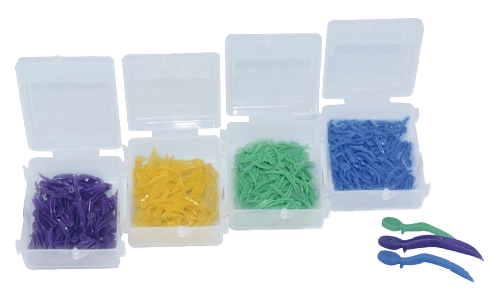
- 새로운 플라스틱 폴리 엣지
- 구멍이있는 둥근 선미
- 쉽게 가져가는 것,부착되지 않은 둥근 가장자리,웨지를 다른 치아 균열로 가득 채울 수있는 유연성을 더 많이 만듭니다.
또는 100 PC/박스,550 상자/ctn
| 크기 | 색상 | 길이 |
|---|---|---|
| 봄 여름 시즌 | 파란색 | 17.8*1.7 mm |
| 에스 | 녹색 | 17.8*2.1 mm |
| 중 | 노란색 | 17.8*2.45 mm |
| 엘 | 보라 | 17.8*2.8 mm |

| 크기 | 색상 | 길이 | 크기 | 색상 | 길이 |
|---|---|---|---|---|---|
| 봄 여름 시즌 | 파란색 | 10*1.8*1.6 mm | 에스 | 녹색 | 12*2*1.8 mm |
| 중 | 노란색 | 14*2.2*2 mm | 엘 | 보라 | 16*2.6*2.4 mm |

| 색상 | 길이 | 색상 | 길이 | 색상 | 길이 |
|---|---|---|---|---|---|
| 주황색 | 1.2*1.5*12 mm | 보라 | 2*2*15 mm | 녹색 | 1.5*2*14 mm |
| 노란색 | 1.3*2*16 mm | 분홍색 | 1.5*2*16 mm | 하얀색 | 1.3*1.5*14 mm |
치과 웨지는 현대 치과 치료에서 매우 중요한 역할을하며 치아 복원을위한 대체 할 수없는 도구입니다., 치열 교정, 그리고 다른 분야. 적절한 치과 웨지를 선택하여 치료 효과를 향상시키고 환자를 줄입니다.’ 불편감.
자세한 내용, 저희에게 연락하십시오.
치과 웨지: 그만큼 "작은 조수" 치아 복원을 위한
치과용 갭 웨지 (치과용 웨지라고도 알려져 있음) 치아를 분리하고 잇몸을 보호하기 위해 구강 치료에 사용되는 중요한 도구입니다.. 보통 나무나 플라스틱으로 만들어진다.. 작은 크기에도 불구하고, 이는 치아 충전재 및 베니어 복원과 같은 치료에서 중요한 역할을 합니다., 특히 복합 수지와 같은 작업에서, 유리 이온 시멘트 및 은 아말감 충전재. 치간 틈에 쐐기를 삽입하여, 치아 사이의 공간을 효과적으로 제어할 수 있습니다., 잇몸을 보호할 수 있어요, 그리고 수복물의 모양은 조정될 수 있습니다, 이를 통해 치료 성공률과 안정성을 높인다..
치아 웨지의 기능
- 치아의 인접한 표면을 분리합니다.
치아를 메우거나 인접 표면의 우식을 복원할 때, 치아 사이에 치과용 웨지를 삽입하여 잇몸을 분리하고 매트릭스 밴드를 고정합니다., 수복 재료가 인접한 치아나 잇몸에 달라붙는 것을 방지합니다.. - 치주 조직을 보호하십시오
잇몸을 살짝 짜서, 수술 기구로 인한 연조직 손상이 감소됩니다., 수술 후 잇몸 출혈의 위험이 낮아집니다.. - 보조 성형
수복물이 치아의 인접한 표면에 밀접하게 부착되어 수복 후 돌출이나 음식 매복과 같은 합병증을 방지하는지 확인하십시오..
치과용 웨지의 분류
나무로 되는 치과 쐐기
포플러, 자작나무 등의 부드러운 목재 소재로 제작되었습니다., 비용이 저렴하고 가지치기가 쉽다는 장점이 있습니다.. 치아 사이의 간격에 따라 크기 조절이 가능합니다., 나무는 자연적인 탄력성이 좋습니다, 인접한 치아의 치주 조직 손상을 줄일 수 있습니다.. 하지만, 목재 치과 웨지의 단점은 수분 흡수력이 강하다는 것입니다., 팽창과 변형이 일어나기 쉽습니다., 상대적으로 강도가 낮고. 사용시 주의가 필요합니다.
플라스틱 치과 웨지
일반적으로 폴리에틸렌과 같은 재료로 만들어집니다., 폴리프로필렌 또는 나일론으로 현대 치과에서 널리 사용됩니다.. 다른 경도에 따르면, 로 분류될 수 있다:
- 견고한 플라스틱 치과용 웨지: 고강도 및 안정적인 형태, 간격이 크거나 인접 치아의 헐거움이 적은 상황에 적합.
- 탄성 플라스틱 치과용 웨지: 어느 정도 탄력성을 가지고 있어요, 불규칙한 공간에도 적응 가능, 잇몸에 가해지는 압력을 줄여라, 잇몸이 민감하거나 공간이 좁은 환자에게 적합합니다..
플라스틱 치과용 웨지의 일반적인 장점은 방수 기능이 있다는 것입니다., 깨지기가 쉽지 않습니다, 매끄러운 표면을 가지고 있다, 수복물에 대한 접착력을 감소시킵니다.. 모양에 따라, 플라스틱 치과 웨지는 칼 모양과 같은 다양한 유형으로 제공됩니다., 칼 모양의, 및 자체 적응 유형. 치아 인접면의 상태에 따라 적절한 유형을 선택할 수 있습니다..
치과용 웨지의 재료 선택
핵심 재료 특성 요구 사항:
- 생체 적합성: 재료는 구강점막에 자극반응이 없어야 한다., 잇몸과 치아 조직, 알레르기 반응이나 염증을 피하는 것, 특히 잇몸과 장기간 접촉하는 부위의 경우. 치과 생물안전 표준을 준수해야 합니다. (ISO와 같은 10993).
- 기계적 성질: 작업 중 압력에 쉽게 부서지지 않고 견딜 수 있는 충분한 강도와 인성을 가져야 합니다.. 동시에, 치아나 치주 조직에 손상을 일으키는 과도한 강성을 피하기 위해 다양한 간격 모양에 적응할 수 있어야 합니다..
- 물리적 안정성: 재료가 물을 흡수해서는 안 됩니다., 입안의 습한 환경에서 변형되거나 용해됨, 타액으로 인한 형태학적 변화를 피하고 회복 효과에 영향을 미침. 금속재료는 내식성을 가져야 한다, 플라스틱 재료는 노화에 대한 저항력이 있어야 합니다..
- 운영 편의성: 재료는 손질이 쉬워야 한다, 모양을 만들거나 소독하다, 수리 재료에 대한 접착력을 감소시키는 매끄러운 표면, 잔해물을 남기지 않고 수술 후 제거를 촉진합니다..
수복물 재료에 따라 다양한 치과용 웨지를 선택하세요.
- 복합레진 충진: 레진이 웨지에 달라붙어 수복물 가장자리의 견고성에 영향을 미치는 것을 방지하기 위해 접착되기 쉽지 않은 매끄러운 표면을 가진 플라스틱 치과용 웨지를 선택하십시오..
- 은 아말감 충전: 목재 치과용 웨지 또는 단단한 플라스틱 치과용 웨지를 선택할 수 있습니다.. 경화 중 은아말감의 부피 수축이 적기 때문에, 치과용 웨지에 대한 안정성 요구 사항은 상대적으로 낮습니다..
- 유리이온 시멘트 충진: 수분 흡수로 인해 나무 쐐기가 팽창하는 것을 방지하려면 비흡수성 플라스틱 쐐기를 선택하세요., 시멘트의 경화 효과에 영향을 미칠 수 있는 것.
치과용 웨지의 임상적 적용
치아 웨지 배치 단계
- 간격 위치 지정: 핀셋을 사용하여 치아 웨지를 고정하세요., 영향을 받은 치아와 인접한 치아 사이의 틈에 팁을 정렬합니다., 기울어지는 것을 방지하기 위해 치과용 웨지의 장축이 치아의 장축과 평행한지 확인하십시오..
- 프로그레시브 임베딩: 손가락이나 치과용 웨지 클립을 사용하여 틈새로 부드럽게 밀어 넣습니다., 잇몸 손상이나 인접한 치아의 변위를 유발할 수 있는 갑작스러운 힘을 피하기 위해 점차적으로 힘을 가함, 치아 웨지의 바닥이 교합면과 동일하거나 약간 낮을 때까지.
- 직위 심사: 치과용 프로브를 사용하여 치과용 웨지의 위치를 확인하여 잇몸이 눌려져 있는지 확인하세요., 치간 간격이 완전히 노출되었는지 여부, 치아 웨지가 안정적인지 여부.
수술 중 협력 및 수술 후 제거:
- 수술 중 협력: 수복재료를 채울 때, 재료의 충전 압력으로 인해 치과용 웨지가 변위되는 것을 방지하기 위해 치과용 웨지의 위치를 정기적으로 확인하십시오.. UV 경화형 복합수지를 사용하는 경우, 경화 효과에 영향을 미치지 않도록 치과용 웨지가 조명된 영역을 차단하지 않는지 확인하십시오..
- 수술 후 제거: 수복재료가 굳은 후, 핀셋을 사용하여 치과용 웨지의 바닥을 가볍게 잡고 매립 방향을 따라 천천히 제거하십시오. 당기면 수복물이 손상되거나 잇몸이 손상될 수 있습니다.. 제거 후, 수복물의 인접한 표면의 모양, 변연 적합도와 치은 상태를 검사해야 합니다..
치과용 웨지 사용 시 주의사항
- 치아 사이의 틈 모양을 일치시킵니다.
웨지의 크기가 적당해야합니다. 너무 큰 경우, 잇몸에 압력을 가할 수 있습니다.. 너무 작은 경우, 매트릭스 밴드를 제자리에 고정할 수 없습니다.. 치아 사이의 틈의 입체적인 형태를 바탕으로 적합한 웨지를 선택하세요.. - 폭력적인 수술을 피하십시오
삽입할 때, 쐐기가 부러지거나 잇몸이 손상되는 것을 방지하기 위해 천천히 압력을 가하십시오.. - 특수환자는 주의해서 사용해야 합니다
잇몸퇴축이 심하거나 치아 사이의 간격이 넓은 환자의 경우, 다른 악기와 함께 사용하는 것이 좋습니다 (쉐이핑 클램프와 같은).
FAQ
치과 웨지는 보조 도구입니다, 보통 나무나 플라스틱으로 만들어진다., 수복 치료 중 인접한 표면 매트릭스 밴드를 고정하는 데 사용됩니다..
- 매트릭스 밴드 안정화: 레진 충진 시 소재 넘침 방지.
- 잇몸을 보호하세요: 잇몸을 눌러 수축시켜 기구 작동으로 인한 연조직의 손상을 줄입니다..
- 인접관계를 유지하라: 수복물과 인접 치아 사이의 접촉점이 자연스러운 모양인지 확인하십시오..
소재별: 플라스틱 웨지 (일회용의), 나무 웨지 (물 흡수 및 팽창).
디자인에 따르면: 스트레이트 웨지, 호 모양의 쐐기 (치아의 해부학적 곡률에 맞춰).
크기별: XS 등 다양한 사양으로 제공, 에스, 중, 그리고 엘, 다양한 톱니 간격 폭을 수용하기 위해.
- 잇몸 손상: 부적절한 작동으로 인해 점막 찰과상이나 궤양이 발생할 수 있습니다..
- 복원의 결함: 웨지의 부적절한 위치로 인해 충진 본체의 인접성이 좋지 않거나 정지될 수 있습니다..

